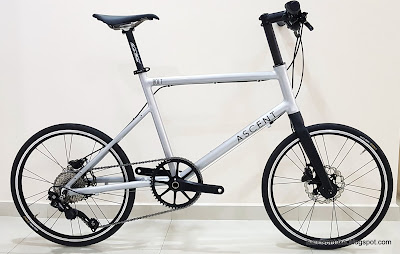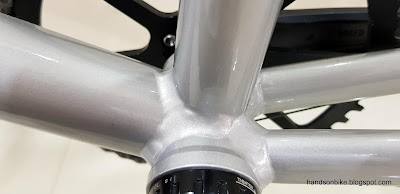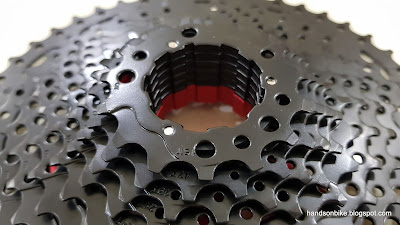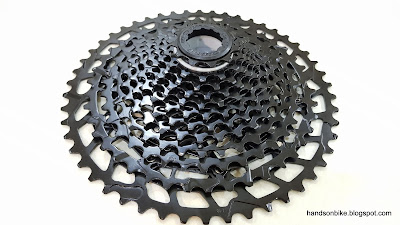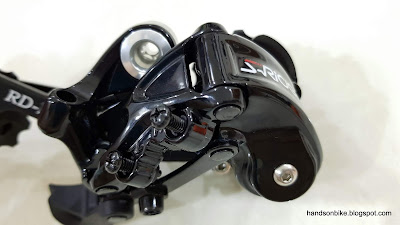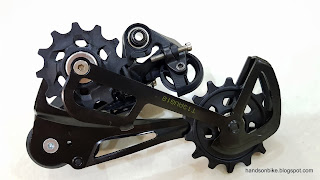As for mini velos, they are also fun to ride, as the small wheels provide a nimble ride which is what you cannot find on a bike with larger wheels such as road bikes or mountain bikes. For city riding, a mini velo is very suitable as it is easy to ride even at slow speeds, while the shorter length (due to smaller wheels with same wheelbase) makes it easy to store, transport in cars, or go into elevators.
Folding bikes can also provide the same fun ride, but they are heavier and need more maintenance due to the folding joints. If you don't need the folding feature, mini velos are your best choice for city riding.
I have previously built the Wheelsport Fantasy Mini Velo, as well as the very lightweight Java Freccia Carbon Mini Velo. Regardless of a flat handlebar setup or a drop bar setup, a mini velo is fun to ride.
Recently, Ascent Bikes have a lightweight mini velo that looks very good, with a high quality lightweight aluminium frame and a reasonable price. Compared to a Tyrell, it is both cheaper and lighter, which is fantastic.
I was offered a chance to borrow a mini velo from Ascent Bikes, and I took the chance to try it out and see how it differs from my other mini velos. It has a different setup which I have not tried before, which is hydraulic disc brakes on a mini velo. I am a fan of hydraulic disc brakes, as they provide good stopping power in all weather conditions, effortlessly. This can be seen most clearly on the Canyon Endurace road bike and the Fabike C3 commuting bike, which are my two main bikes nowadays.
The demo bike for the Bolt mini velo from Ascent Bikes, which looks really good with the 451 wheels and black components.
External routing on this aluminium frame, for easy setup and servicing.
Tall head tube on the frame, which is also a good place to strap on a set of front lights.
The welding on the frame is excellent, as the welds are polished to achieve the joint smoothness which makes it look really premium.
Excellent welds at all the joints, plus the very smooth paint and clear coat, as you can see from the reflections.
Bottom bracket area. The smooth finishing on the frame makes it super easy to wipe off any grease or dirt, unlike the matte finishing on some carbon frames.
The highlight of this Ascent Bolt mini velo is no doubt the frame, as the paint job is of very high quality, plus it is also quite lightweight (1380 grams) for an aluminium mini velo frame, according to Ascent Bikes. This is already considered lightweight for an aluminium mini velo frame, as the Wheelsport Fantasy aluminium mini velo frame is quite a lot heavier at 1759 grams.
Carbon front fork for the Ascent Bolt mini velo!
The front wheel looks pretty lightweight, with an attractive spoke pattern and low profile wheels. You can also opt for high profile carbon wheels if you prefer that look.
This carbon front fork (100m OLD) can also accept road caliper brakes instead of hydraulic disc brakes, if you prefer it that way.
I was told that this carbon front fork was specially designed to accommodate both 406 or 451 wheels. If you use 406 wheels, you can use wide tires, while 451 wheels will use narrower tires but still with plenty of clearance. There is also a choice of road caliper brakes or disc brakes. If you choose 406 wheels, you have to use disc brakes as caliper brakes cannot reach the rim or go around the wide tire. For 451 wheels, either caliper brakes or disc brakes will work. Front fork weighs about 390 grams according to Ascent Bikes.
Post Mount disc brake mounting on the front fork, with a default rotor size of 160mm. Also note the mounting point for a front mudguard if you want to install one.
Rear OLD is 135mm, with Post Mount disc brake mounting and the same default rotor size of 160mm.
Note the two mounting points for a rear rack and rear mudguard if you want to install them. This frameset is very versatile as it can accommodate all these add-ons if necessary.
The design of the 6 bolt rotor is nice, with a black aluminium spider and stainless steel braking surface.
Same as the front, the rear can also use a road caliper brake which is mounted on the bridge between the seatstays.
In-house crankset by Ascent Bikes, which uses a Hollowtech II type of spindle with forged crankarms. The narrow-wide chainrings are of direct mount type and the size can be changed as necessary.
A standard 68mm wide road bottom bracket is used, which is really good for serviceability. Left side crankarm is installed in a similar way to a Shimano crankset.
1x10 speed drivetrain, which is pretty much all you need for city riding.
Deore M6000 rear derailleur, plus a 11-32T 10 speed cassette gives you good range and gear step for city riding.
Carbon handlebar, plus aluminium stem and ergonomic grips.
Deore 10 speed shifter, paired with Shimano BL-MT200 hydraulic brakes. Affordable yet works well.
View of the full bike again! Clean lines, good looking frame and an affordable price makes this mini velo a good choice.
This mini velo weighs 7.8 kg without pedals or other accessories, which is what you see in the picture above. This is a very good weight, considering that these are mostly average components without any weight weenie parts. A folding bike with an equivalent setup, such as the Dahon MuEX, will weigh about 1 kg more and also cost more. As mentioned earlier, if you don't need the folding feature, a mini velo is a better choice than a folding bike, if you want a small wheeled bike.
If you have the budget, you can save quite a lot of weight by upgrading to even lighter components. The best thing about Ascent Bikes is that they allow full customization of the components that you want, and they will build the bike for you. This means that you can specify exactly what you want, to meet your specific needs.
Want wide tires for light off road? Go for 406 wheels plus disc brakes.
Want to ride fast? Use a drop bar with aerodynamic high profile carbon wheels.
Want to use it as a commuting bike? Attach a rear rack and mudguards for more practicality.
and so on...
In the next post, I will compare the Ascent Bolt mini velo to the Dahon MuEX, and also do a ride review. I was able to borrow this bike for a couple of weeks and thus I was able to customize it slightly and also use it for extended rides for a better feel of the bike.
